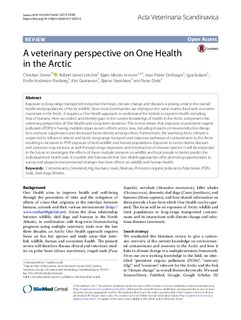| dc.contributor.author | Sonne, Christian | |
| dc.contributor.author | Letcher, Robert James | |
| dc.contributor.author | Jenssen, Bjørn Munro | |
| dc.contributor.author | Desforges, Jean-Pierre | |
| dc.contributor.author | Eulaers, Igor | |
| dc.contributor.author | Andersen-Ranberg, Emilie | |
| dc.contributor.author | Gustavson, Kim | |
| dc.contributor.author | Styrishave, Bjarne | |
| dc.contributor.author | Dietz, Rune | |
| dc.date.accessioned | 2018-08-24T11:43:47Z | |
| dc.date.available | 2018-08-24T11:43:47Z | |
| dc.date.created | 2018-01-20T14:40:56Z | |
| dc.date.issued | 2017 | |
| dc.identifier.citation | Acta Veterinaria Scandinavica. 2017, 59 . | nb_NO |
| dc.identifier.issn | 1751-0147 | |
| dc.identifier.uri | http://hdl.handle.net/11250/2559237 | |
| dc.description.abstract | Exposure to long-range transported industrial chemicals, climate change and diseases is posing a risk to the overall health and populations of Arctic wildlife. Since local communities are relying on the same marine food web as marine mammals in the Arctic, it requires a One Health approach to understand the holistic ecosystem health including that of humans. Here we collect and identify gaps in the current knowledge of health in the Arctic and present the veterinary perspective of One Health and ecosystem dynamics. The review shows that exposure to persistent organic pollutants (POPs) is having multiple organ-system effects across taxa, including impacts on neuroendocrine disruption, immune suppression and decreased bone density among others. Furthermore, the warming Arctic climate is suspected to influence abiotic and biotic long-range transport and exposure pathways of contaminants to the Arctic resulting in increases in POP exposure of both wildlife and human populations. Exposure to vector-borne diseases and zoonoses may increase as well through range expansion and introduction of invasive species. It will be important in the future to investigate the effects of these multiple stressors on wildlife and local people to better predict the individual-level health risks. It is within this framework that One Health approaches offer promising opportunities to survey and pinpoint environmental changes that have effects on wildlife and human health. | nb_NO |
| dc.language.iso | eng | nb_NO |
| dc.publisher | BioMed Central | nb_NO |
| dc.rights | Navngivelse 4.0 Internasjonal | * |
| dc.rights.uri | http://creativecommons.org/licenses/by/4.0/deed.no | * |
| dc.title | A veterinary perspective on One Health in the Arctic | nb_NO |
| dc.type | Journal article | nb_NO |
| dc.type | Peer reviewed | nb_NO |
| dc.description.version | publishedVersion | nb_NO |
| dc.source.pagenumber | 11 | nb_NO |
| dc.source.volume | 59 | nb_NO |
| dc.source.journal | Acta Veterinaria Scandinavica | nb_NO |
| dc.identifier.doi | 10.1186/s13028-017-0353-5 | |
| dc.identifier.cristin | 1548264 | |
| dc.description.localcode | © The Author(s) 2017. This article is distributed under the terms of the Creative Commons Attribution 4.0 International License (http://creativecommons.org/licenses/by/4.0/) | nb_NO |
| cristin.unitcode | 194,66,10,0 | |
| cristin.unitname | Institutt for biologi | |
| cristin.ispublished | true | |
| cristin.fulltext | original | |
| cristin.qualitycode | 1 | |

